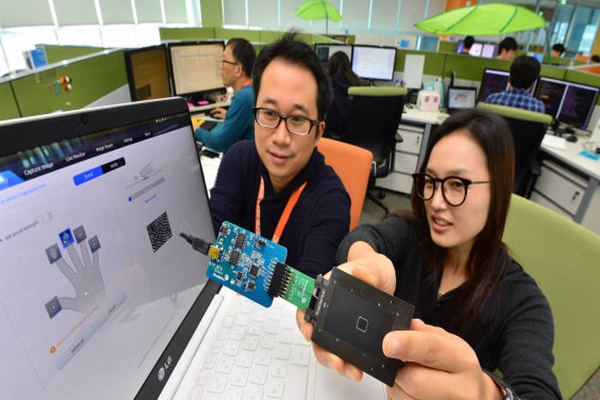Fingerprint recognition algorithm for small area that can reduce surface of a sensor that is needed for fingerprint recognition by a third has finally come out.
It can be loaded onto any fingerprint recognition modules such as volume controller, sides and others because it can reduce sizes of modules while maintaining fast speed and high security.
Crucialtec (CEO An Keon Joon and Kim Jong Bin) made an announcement on the 27th that its affiliate Crucial Soft has developed micro-surface area fingerprint recognition algorithm ‘Muon’ and is going to supply to domestic and foreign businesses.
With a minimum recognition surface area of 8 mm2, it can recognize a fingerprint on the top of a sensor even if its size is about a nail and it is an accurate algorithm with a false acceptance rate (FAR) less than 1/50000. Performance of fingerprint recognition functions are affected by sensors that read fingerprint patterns and algorithms. When algorithms are excellent, it can supplement accuracy and recognition speed even if sensor functions are bit poor.
Until now, fingerprint recognition modules that were chosen for Smartphones were mostly put into spaces such as home buttons, rear buttons and others that can secure more than certain surface area because they had to meet minimum surface area where algorithm can distinguish characteristics of fingerprints. Due to sizes of modules, products’ designs and sensors that can be chosen were limited.
Muon algorithm that is developed by Crucial Soft can detect a fingerprint on a censor’s surface area as small as 18.72 mm2 (5.2 x 3.6 mm). It is known that FPC 1025 sensor that is mostly used in Android OS Smartphones such as recently released Google Nexus 5X and Nexus 6P has a surface area of 64 mm2 (8.0 x 8.0 mm).

If size of a sensor decreases, size of a module can be greatly reduced. It can be put into side power button and volume controller, and there can be room in inner mounting spaces. Because recognition performance per surface area increases due to algorithm, range of sensor choices can be expanded. On medium and low-priced Smartphones, it will maintain same size of a module as before but a much cheaper sensor can be used.
Crucial Soft also strengthened security. It performs all 3 steps of fingerprint recognition processing such as image preprocessing, extraction of characteristics, and storage of template (encoding of biometrics information) inside of Trust Zone and its recognition speed is only 0.3 seconds. Although Trust Zone is separated physically from memory and safe from hackings, its speed is very slow as surrounding motors such as AP and RAM are poor.
Because recognition speed can be slowed if many steps are processed in Trust Zone, current businesses made it so that only template storage is mostly done in Trust Zone. This can lead to possible extortion of fingerprint images outside of Trust Zone.
Crucialtec is planning to strengthen its competitive edge by supplying Muon algorithm along with its major fingerprint recognition module project BTP (BiometricTrack Pad) to its customers. As fingerprint recognition comes with Google Android 6.0 Marshmallow OS, it is hoping that demands for Smartphone fingerprint recognition solutions will increase hereafter.
“Many businesses are showing much interest as ultra-small fingerprint recognition IC can be used and sizes of modules can be reduced if Muon algorithm is applied. According to expansion of supplies of BTP, we will be able to supply it in a form of a solution to many customers.” said CEO An Keon Joon of Crucialtec.
Staff Reporter Park, Jungeun | jepark@etnews.com